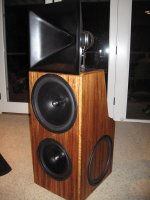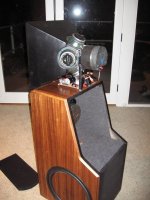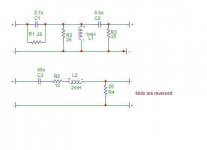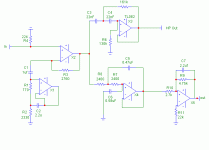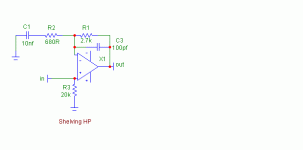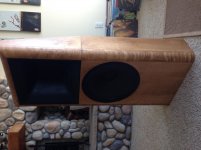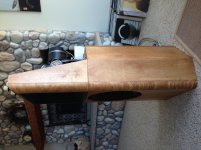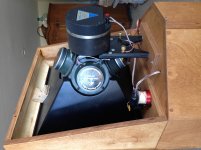Finally got all the pieces and constructed the enclosures. The horn was Nick Mckinney's last unit. He supplied the horn, passive crossover components for the horn, and the mid drivers. I'm using TAD 2001 for the tweeters. The bass unit is a 15" Lambda TDX Apollo and the sub is a 12" Lambda TDX faraday motor with two 15" PR's at about 1500g each. The sub enclosure is about 2.5 cu ft (around 32L). As you can see from the pics, the bass is a sort of modified open baffle, or a short U-frame.
My ultimate plan is to have 4 channels of amplification per side. Because the horn crossover can be made phase correct, I will probably do that as an active line level crossover. The crossover to the bass and to the sub will be with FIR filters. I will do equalization with the FIR as well, much as discribed in this thread by John Hancock: http://www.diyaudio.com/forums/showthread.php?s=&threadid=17642&highlight=
I may do it by PC, but I'm leaning toward DEQX for now, as I'm not sure I want to deal with the steeper learning curve of the PC approach.
Here's the front view.
My ultimate plan is to have 4 channels of amplification per side. Because the horn crossover can be made phase correct, I will probably do that as an active line level crossover. The crossover to the bass and to the sub will be with FIR filters. I will do equalization with the FIR as well, much as discribed in this thread by John Hancock: http://www.diyaudio.com/forums/showthread.php?s=&threadid=17642&highlight=
I may do it by PC, but I'm leaning toward DEQX for now, as I'm not sure I want to deal with the steeper learning curve of the PC approach.
Here's the front view.
Attachments
Here' s the passive crossover for the mid/tweet that Nick sent with the horn. I may use a passive here for a while, while I build the amps. I did some measurements and had a surprising finding. The tweeter run full range had the expected profile. It rolled off around 250hz, IIRC, and above about 2500 rolled off at 6db. With the crossover, it rolled off around 1200 on the lower end and, with the shelving high pass, had less roll off up high. The surprise was that there was a lot of lower frequency stuff in the spectrum that did not appear without the crossover. Why would that be. I'll try to post some spectra, if I can figure out how to record them from LspCAD (Just MLS). The program has an export function, but I can't find the images.
Sheldon
Sheldon
Attachments
Lambda Drivers
Hi Sheldon,
Good to see you got all your drivers from Nick and have assembled your speakers. I was one of about four of us that were very anxious if we would ever see our drivers from Nick. My system is complete now and I am quite satisfied with the results. I think Stryke Audio has taken over the Lambda line. Have you heard anything on this.
Regarding the xover, I went with a 3 channel XM44 Marchand electronic xover and works very nice. They also have a 4 channel available.
Hi Sheldon,
Good to see you got all your drivers from Nick and have assembled your speakers. I was one of about four of us that were very anxious if we would ever see our drivers from Nick. My system is complete now and I am quite satisfied with the results. I think Stryke Audio has taken over the Lambda line. Have you heard anything on this.
Regarding the xover, I went with a 3 channel XM44 Marchand electronic xover and works very nice. They also have a 4 channel available.
Re: Lambda Drivers
Thanks guys,
Laminating the veneer (Koa) is not much fun, but it looks very nice, so I wanted to cover as much as I could. I laminated the cut-outs to a 1/8" (3mm) thick piece of high density fiberboard, then attached that with double sided mounting tape.
Thanks for the info. Are your crossovers speaker level or line level on the horn? Orders and freq.?
Yes, Acoustic Elegance (formerly Stryke) did purchase Nick's remaining stock of parts and is making some of the Lambda drivers. I got the 12"er from John J.. That took a while too, as he had his own string of setbacks to sort out. Seems like he might be back on track now. I had originally planned to make a 75L box with just the one 15" and the PR's. But playing around I decided I liked the open backed woofer a little better, so divided the box in two and added the 12" to cover below about 50. In theory, the OB woofer might give me a little better match in directivity for the horn.
Sheldon
Thanks guys,
Cal Weldon said:I especially like the finish on the drones, using the cut out for the cover piece.
Laminating the veneer (Koa) is not much fun, but it looks very nice, so I wanted to cover as much as I could. I laminated the cut-outs to a 1/8" (3mm) thick piece of high density fiberboard, then attached that with double sided mounting tape.
lcsegeng said:Hi Sheldon,
Good to see you got all your drivers from Nick and have assembled your speakers. I was one of about four of us that were very anxious if we would ever see our drivers from Nick. My system is complete now and I am quite satisfied with the results. I think Stryke Audio has taken over the Lambda line. Have you heard anything on this.
Regarding the xover, I went with a 3 channel XM44 Marchand electronic xover and works very nice. They also have a 4 channel available.
Thanks for the info. Are your crossovers speaker level or line level on the horn? Orders and freq.?
Yes, Acoustic Elegance (formerly Stryke) did purchase Nick's remaining stock of parts and is making some of the Lambda drivers. I got the 12"er from John J.. That took a while too, as he had his own string of setbacks to sort out. Seems like he might be back on track now. I had originally planned to make a 75L box with just the one 15" and the PR's. But playing around I decided I liked the open backed woofer a little better, so divided the box in two and added the 12" to cover below about 50. In theory, the OB woofer might give me a little better match in directivity for the horn.
Sheldon
Re: Re: Lambda Drivers
Not wood glue? Hope they stay in place for you. Not sure I would trust the tape.
Sheldon said:then attached that with double sided mounting tape.
Not wood glue? Hope they stay in place for you. Not sure I would trust the tape.
Re: Re: Re: Lambda Drivers
We'll see. No harm, no foul, if the tape doesn't hold up. However, these kind of tapes come in all sorts of grades. Body panels, etc.., to many automobiles are held on this way. Some grades are as tough as most glues, and more flexible. The stuff I used is a medium strength polyester foam tape.
Sheldon
Cal Weldon said:
Not wood glue? Hope they stay in place for you. Not sure I would trust the tape.
We'll see. No harm, no foul, if the tape doesn't hold up. However, these kind of tapes come in all sorts of grades. Body panels, etc.., to many automobiles are held on this way. Some grades are as tough as most glues, and more flexible. The stuff I used is a medium strength polyester foam tape.
Sheldon
Re: Re: Re: Re: Lambda Drivers
Nevermind that one. Turns out it was a problem with my measurement system, caused by poor connection. No such behavior on retest.
Sheldon
Sheldon said:The surprise was that there was a lot of lower frequency stuff in the spectrum that did not appear without the crossover.
Sheldon
Nevermind that one. Turns out it was a problem with my measurement system, caused by poor connection. No such behavior on retest.
Sheldon
Hi Sheldon,
Building a Unity Horn in on my list of things to do, so I appreciate you sharing your experience.
I am surprised that you found using the Lambda TD15X as a dipole midbass gave the best sound when integrating with the Unity horn at 300Hz and a monopole subwoofer. Can you elaborate on any modeling or experiments that moved you in this design direction?
I use several standard Lambda TD15S, and found from both modeling and listening that a sealed box with active bass compensation and room equalization measured and sounded best.
Fiberglass insulation suspended on bracing in the middle of the cabinet seemed to help keep the midbass clean when crossing a TD15 at 300Hz.
Building a Unity Horn in on my list of things to do, so I appreciate you sharing your experience.
I am surprised that you found using the Lambda TD15X as a dipole midbass gave the best sound when integrating with the Unity horn at 300Hz and a monopole subwoofer. Can you elaborate on any modeling or experiments that moved you in this design direction?
I use several standard Lambda TD15S, and found from both modeling and listening that a sealed box with active bass compensation and room equalization measured and sounded best.
Fiberglass insulation suspended on bracing in the middle of the cabinet seemed to help keep the midbass clean when crossing a TD15 at 300Hz.
Re: Re: Lambda Drivers
I built a conventional 3 way system, see my son's post of the speakers at http://www.diyaudio.com/forums/showthread.php?s=&threadid=36005
They are crossed at 350Hz and 3000Hz. I had a passive crossover between the PHL 1240s and the Raven R2s which I have since removed and whent entirely active. I played arround with a pair of subs that I built using 12" Shivas, but I find I prefer the low end of the Lambda TDX12's better by themselvs. I had Phil at Marchard Electronics make a pair of Linkwitz Transform cards for the XM44 which really lowers the bottom end of the 12" Lambdas.
I completed them about year and a half ago, and so far, no complaints.
Larry Cleven
Sheldon said:Thanks guys,
Thanks for the info. Are your crossovers speaker level or line level on the horn? Orders and freq.?
Sheldon
I built a conventional 3 way system, see my son's post of the speakers at http://www.diyaudio.com/forums/showthread.php?s=&threadid=36005
They are crossed at 350Hz and 3000Hz. I had a passive crossover between the PHL 1240s and the Raven R2s which I have since removed and whent entirely active. I played arround with a pair of subs that I built using 12" Shivas, but I find I prefer the low end of the Lambda TDX12's better by themselvs. I had Phil at Marchard Electronics make a pair of Linkwitz Transform cards for the XM44 which really lowers the bottom end of the 12" Lambdas.
I completed them about year and a half ago, and so far, no complaints.
Larry Cleven
LineSource said:Hi Sheldon,
Building a Unity Horn in on my list of things to do, so I appreciate you sharing your experience.
I am surprised that you found using the Lambda TD15X as a dipole midbass gave the best sound when integrating with the Unity horn at 300Hz and a monopole subwoofer. Can you elaborate on any modeling or experiments that moved you in this design direction?
I didn't do a lot of modeling - a little with LspCAD - mainly on the bass extension with PR's in 75 and 37L boxes. I built a 75l box with the PR's and listened with it sealed, then partitioned the cabinet and listened with the top half open in the back. That sounded a little better to me - a little livelier. This was done with Nick's passive crossover on the horn and a cobbled together line level 2nd order crossover at 300 on the bass. Level setting was very approximate - a less sensitive amp on the top. The sealed 12" with PR's were not included in the test - only the 15", closed 75L or open 37L. Now, this is clearly a poorly designed experiment and it may bear little relationship to how things would sound with properly designed and calibrated crossovers. But I also figured that the semi dipole configuration might give a little better matching than the box with the polar radiation pattern of the horn. Note also that I reduced the depth of the "U frame" in the version shown. So in reality, it's almost a complete WAG at this point. We'll see how this all sorts out.
Sheldon
Re: Re: Re: Lambda Drivers
Thanks. I thought you were talking about a Unity project. I see from that thread that it's a more conventional set-up. A very nice set-up indeed. Terrific work on those cabinets too. I agree on the Raven's. My current speakers are a three way with passive crossovers and a Raven R1. They do sound nice.
Now you've gotta try making some amps.
Sheldon
lcsegeng said:
I built a conventional 3 way system, see my son's post of the speakers at http://www.diyaudio.com/forums/showthread.php?s=&threadid=36005
They are crossed at 350Hz and 3000Hz. I had a passive crossover between the PHL 1240s and the Raven R2s which I have since removed and whent entirely active. I played arround with a pair of subs that I built using 12" Shivas, but I find I prefer the low end of the Lambda TDX12's better by themselvs. I had Phil at Marchard Electronics make a pair of Linkwitz Transform cards for the XM44 which really lowers the bottom end of the 12" Lambdas.
I completed them about year and a half ago, and so far, no complaints.
Larry Cleven
Thanks. I thought you were talking about a Unity project. I see from that thread that it's a more conventional set-up. A very nice set-up indeed. Terrific work on those cabinets too. I agree on the Raven's. My current speakers are a three way with passive crossovers and a Raven R1. They do sound nice.
Now you've gotta try making some amps.
Sheldon
Current Status
The cabinets and drivers are as described above. The amp set up is as follows:
A stereo low power SET for the TAD's: http://www.diyaudio.com/forums/showthread.php?postid=883561#post883561
Another of the same for the mid drivers. They are crossed over at about 1100Hz with a 48dB digital filter, using a DEQX.
The DEQX also handles the crossover from the horn to the woofer and sub. This crossover is at about 350Hz at 96dB/octave.The DEQX has only three channels, so one output goes to the combination of the U-frame 15" woofer and the 10" sub.
The crossover between woofer and sub is active line level. It's an 80Hz transient perfect filter (using a calculator from the FRD Consortium site): http://www.pvconsultants.com/audio/tp/tpdgam.htm
The overall response is then corrected with the room correction feature of the DEQX.
One additional refinement was to make two line level corrections to preserve max dynamic range of the DEQX. The first was to compensate for the tweeter response. In the constant directivity horn, the TAD response falls off above about 4.5kHZ, at 6dB/octave. So I added an active shelving HP filter between the DEQX output and the tweeter amp. Thanks SL for the info: http://www.linkwitzlab.com/filters.htm#6
After room measurements, I also boosted the region below 50hZ with a shelving LP. That way, the raw measurements were within about dB +/-, before the DEQX correction.
Here's the 80hZ crossover with the shelving LP:
The cabinets and drivers are as described above. The amp set up is as follows:
A stereo low power SET for the TAD's: http://www.diyaudio.com/forums/showthread.php?postid=883561#post883561
Another of the same for the mid drivers. They are crossed over at about 1100Hz with a 48dB digital filter, using a DEQX.
The DEQX also handles the crossover from the horn to the woofer and sub. This crossover is at about 350Hz at 96dB/octave.The DEQX has only three channels, so one output goes to the combination of the U-frame 15" woofer and the 10" sub.
The crossover between woofer and sub is active line level. It's an 80Hz transient perfect filter (using a calculator from the FRD Consortium site): http://www.pvconsultants.com/audio/tp/tpdgam.htm
The overall response is then corrected with the room correction feature of the DEQX.
One additional refinement was to make two line level corrections to preserve max dynamic range of the DEQX. The first was to compensate for the tweeter response. In the constant directivity horn, the TAD response falls off above about 4.5kHZ, at 6dB/octave. So I added an active shelving HP filter between the DEQX output and the tweeter amp. Thanks SL for the info: http://www.linkwitzlab.com/filters.htm#6
After room measurements, I also boosted the region below 50hZ with a shelving LP. That way, the raw measurements were within about dB +/-, before the DEQX correction.
Here's the 80hZ crossover with the shelving LP:
Attachments
Re: Current Status
Sorry, that should read "within about +-5dB.
Sheldon said:That way, the raw measurements were within about dB +/-, before the DEQX correction.
Sorry, that should read "within about +-5dB.
update
It's been a while.
Rebuilt the cabinets. Changes:
Added 2" radius rounds to speaker front corners.
Bass changed from Lambda TDX to Altec 416B
Bass cabinet now sealed - approximately 3 cu ft.
Nine amp channels - compression drivers, mids, bass, subs(3)
Compensation and crossovers done by DEQX 2.6P. Subs driven by Mini DSP.
Passive compensation on compression driver and mids. I did this to minimize the dynamic range required of the DEQX for compensation, and to provide protection.
Mid bass high passed only. Output from bass channel of DEQX to input of Mini DSP. The three subs are integrated according to Geddes multi sub protocol. Mains start to roll of about 60Hz.
The DEQX allows input settings to be adjusted about 15 dB in the analog domain, so I can play with different amps and optimize for gain structure. In all cases I set up the gain structure to eliminate the possibility of clipping any of the amps.
I did initial in-room gated measurements with the DEQX to set up the crossovers. For setting up the subs, I used REW because DEQX can measure Left or Right separately but not simultaneously. Proper integration requires measuring under actual listening conditions.
I like what I'm hearing. Final step is to get the speakers outside on a quiet day and get measurements with as long a gate as possible.
Sheldon
edit: pics show up rotated by 90 degrees - not sure why.
It's been a while.
Rebuilt the cabinets. Changes:
Added 2" radius rounds to speaker front corners.
Bass changed from Lambda TDX to Altec 416B
Bass cabinet now sealed - approximately 3 cu ft.
Nine amp channels - compression drivers, mids, bass, subs(3)
Compensation and crossovers done by DEQX 2.6P. Subs driven by Mini DSP.
Passive compensation on compression driver and mids. I did this to minimize the dynamic range required of the DEQX for compensation, and to provide protection.
Mid bass high passed only. Output from bass channel of DEQX to input of Mini DSP. The three subs are integrated according to Geddes multi sub protocol. Mains start to roll of about 60Hz.
The DEQX allows input settings to be adjusted about 15 dB in the analog domain, so I can play with different amps and optimize for gain structure. In all cases I set up the gain structure to eliminate the possibility of clipping any of the amps.
I did initial in-room gated measurements with the DEQX to set up the crossovers. For setting up the subs, I used REW because DEQX can measure Left or Right separately but not simultaneously. Proper integration requires measuring under actual listening conditions.
I like what I'm hearing. Final step is to get the speakers outside on a quiet day and get measurements with as long a gate as possible.
Sheldon
edit: pics show up rotated by 90 degrees - not sure why.
Attachments
Last edited:
- Status
- This old topic is closed. If you want to reopen this topic, contact a moderator using the "Report Post" button.
- Home
- Loudspeakers
- Multi-Way
- Unity Horn Project Progress
